Have you been curious, like me, about water filtration and its importance? I finally did the deep dive into all the research and am excited to share with you the best water filter in my humble opinion! We’ll even go into a cost analysis- you may be surprised!
This post is sponsored by Berkey Water Filters, but all research, thoughts, and conclusions are my own! Thank you for allowing me to create content with the brands I love to continue to bring you content for free!
With the body being made up of 70% water, we all know how important it is to stay hydrated to keep our bodies healthy. Drinking water is a must to being healthy, but what if the water you are drinking is actually potentially harmful?
Most of us aren’t aware of what’s in our water. We simply trust that what shouldn’t be in the water won’t be… Why would anyone let the water be contaminated? The truth of the matter is that no matter where you’re getting water from, if it’s not filtered properly you are most likely drinking contaminated water. Let’s take a look at what is potentially in our tap/bottled water and learn what we can do to make sure our water is safe.
Recent Breaking News about Contaminated Water
You may have been interested in reading this article because of all of the stories that have been breaking news like in Flint, Michigan. There is so much lead in children’s blood that a state of emergency has been declared. (source)
Also, the city of Chicago offered its citizen at-home testing kits to determine if there is lead in their drinking water. The Chicago Tribune’s analysis of the results found that “70 percent of the 2,797 homes tested during the past two years. Tap water in 3 of every 10 homes sampled had lead concentrations above 5 parts per billion, the maximum allowed in bottled water by the U.S. Food and Drug Administration.” (source) The issue in Chicago is the lead pipes that carries the water…
As recent as June 18, 2018, new groundwater contamination has been found (PFOA that we’ll talk about later!) in groundwater near Lake Michigan.
But What Could Possibly Be In Your Tap Water?
Here are some examples of what is potentially in your water source. Read more about this here.
Water Contaminants are categorized into these four categories:
- Physical contaminants primarily impact the physical appearance or other physical properties of water. Examples of physical contaminants are sediment or organic material suspended in the water of lakes, rivers and streams from soil erosion.
- Chemical contaminants are elements or compounds. These contaminants may be naturally occurring or man-made. Examples of chemical contaminants include nitrogen, bleach, salts, pesticides, metals, toxins produced by bacteria, and human or animal drugs.
- Biological contaminants are organisms in water. They are also referred to as microbes or microbiological contaminants. Examples of biological or microbial contaminants include bacteria, viruses, protozoa, and parasites.
- Radiological contaminants are chemical elements with an unbalanced number of protons and neutrons resulting in unstable atoms that can emit ionizing radiation. Examples of radiological contaminants include cesium, plutonium and uranium.
Just to give you an idea of the issues found across the United States water supplies here is a statement from a study done a few years ago. Back in 2013, twenty five U.S. utilities voluntarily participated in a study from the U.S. Geological Society and the Environmental Protection Agency. The preliminary findings, presented at a toxicology conference, found 18 unregulated chemicals in drinking water from more than one-third of U.S. water utilities sampled nationwide. Scientific American says of these chemicals “Included are 11 perfluorinated compounds, an herbicide, two solvents, caffeine, an antibacterial compound, a metal and an antidepressant.”
The most frequent chemicals, perfluorinated chemicals, are widely used in industrial processes like manufacture of some nonstick and stain-resistant food packaging, fabrics, and cookware. The two most common of these compounds, PFOS and PFOA, have been detected in the blood of nearly everyone in the U.S. Everyone!!
From Scientific American: “A panel of scientists concluded that there is a “probable link” between PFOA in drinking water and high cholesterol, ulcerative colitis, thyroid disease, testicular cancer, kidney cancer, and pregnancy-induced hypertension.” (source)
What is the US doing about contaminants in tap water?
The Clean Water Act (CWA) was passed in 1948 and amended in 1973. It is what laid the groundwork for the federal Safe Drinking Water Act (SDWA). This act was passed by Congress in 1974 and it is the main law that protects our nation’s public drinking water. “Unregulated chemicals” means that these chemicals are not regulated under the SDWA, so utilities do not have to keep these chemicals at a certain level or even monitor for them. Find out more about this act here.
The EPA currently regulates about 90 contaminants in our drinking water, including lead, arsenic, and uranium. The thing that blows my mind is how many thousands of chemicals aren’t monitored at all.
Which drinking water contaminants aren’t monitored by the EPA?
The EPA makes what they call “Contaminant Candidate Lists” every five years, then determines from that list contaminants:
- that are currently not subject to any proposed or promulgated national primary drinking water regulations,
- that are known or anticipated to occur in public water systems, and
- which may require regulation under the Safe Drinking Water Act (SDWA).
Some examples of contaminants that aren’t currently monitored include: pesticides, disinfection byproducts, chemicals used in commerce, waterborne pathogens, pharmaceuticals, and biological toxins.
Some Chemicals and Compounds that are on the most recent CCL 4, published on November 17, 2016 (meaning these are still unregulated):
- Aluminum
- Benzyl chloride
- Chlorate
- Formaldehyde
- Methanol
- Nitroglycerin
- PFOA
- PFOS
- Urethane
Some Microbial Contaminants found on CCL 4:
- Adenovirus
- Enterovirus
- Hepatitis A virus
- Salmonella enterica
The Threats to our Drinking Water:
The EPA says “There are a number of threats to drinking water: improperly disposed of chemicals; animal wastes; pesticides; human threats; wastes injected underground; and naturally-occurring substances can all contaminate drinking water.”
Another study by the Toxic Substances Hydrology Program of the U.S. Geological Survey (USGS) shows that a broad range of chemicals found in residential, industrial, and agricultural wastewaters commonly occurs in mixtures at low concentrations downstream from areas of intense urbanization and animal production.
The USGS collected and analyzed water samples from 139 streams in 30 states during 1999 and 2000. Their goal was to determine if harmful chemicals are entering these streams [chemicals such as human and veterinary drugs (including antibiotics), hormones, detergents, disinfectants, plasticizers, fire retardants, insecticides, and antioxidants.]
You won’t believe their findings: “One or more chemicals were detected in 80 percent of the streams sampled, and 82 of the 95 chemicals were detected at least once. Generally, these chemicals were found at very low concentrations (in most cases, less than 1 part per billion). Mixtures of the chemicals were common; 75 percent of the streams had more than one, 50 percent had 7 or more, and 34 percent had 10 or more… Steroids, nonprescription drugs, and insect repellent were the chemical groups most frequently detected. Detergent metabolites, steroids, and plasticizers generally were measured at the highest concentrations.” (source)
Just a *fraction* of the chemicals that could be in your tap water and their effects:
- PFOS: linked to attention disorders in children ages 12-15, thyroid disease in men, and “diagnosed high cholesterol, ulcerative colitis, thyroid disease, testicular cancer, kidney cancer, and pregnancy-induced hypertension.” (source)
- Metolachlor: is an herbicide is used primarily on corn, soybeans and sorghum. The EPA has listed metolachlor as a possible human carcinogen based on studies of highly exposed rats. (source)
- Strontium: is a trace element found in seawater and soil and is similar to calcium. It can affect bone growth, according to some animal studies. There was a prescription for Strontium in Europe called Protelos™. There were significant increases in both heart attacks and blood clots in patients taking strontium ranelate compared those who were not. They found it is also associated with serious skin reactions, disturbances in thinking, seizures, liver inflammation, and reduced numbers of red blood cells. (source)
- Lead: can cause brain and nerve damage, especially in children. (source)
- 1,4 Dioxane: a byproduct of plastic manufacturing. It’s found in paint strippers, varnishes, and waxes. The EPA has classified it as a “likely human carcinogen.” Found in water in at least North Carolina, Colorado, California, New York, New Hampshire, Massachusetts, Connecticut, Rhode Island, Hawaii, and Alaska. The EPA is not currently regularing 1,4 Dioxane in our public water supply. (source)
- Coprostanol: a fecal steroid.
- Cholesterol: a plant and animal steroid.
- N-N-diethyltoluamide: an insect repellent.
- Triclosan: an antimicrobial disinfectant.
- Tri (2-chloroethyl) phosphate: a fire retardant.
- 4-nonylphenol: a nonionic detergent metabolite.
- Hexavalent Chromium: “is one of the valence states (+6) of the element chromium. It is usually produced by an industrial process. Cr(VI) is known to cause cancer. In addition, it targets the respiratory system, kidneys, liver, skin and eyes.” (source)
Yes, it’s true that the concentration of these contaminants is generally very low. But the problem is, we don’t know the long-term effects of these chemicals, even at low levels. If we don’t KNOW, why take the risk?
How Do You Find Out What’s In Your Tap Water?
Sometimes you have to take matters into your own hands. You’re probably wondering what in the world is in your water after reading all of that. No worries friend, I’ve got you covered. Here are some ways you can get down to the bottom of what’s in your water:
- EWG’s Tap Water Database:
The Environmental Working Group has a database of water they’ve tested. They compiled 28 million water records and collected water from nearly 50,000 facilities that serve 280 million people in all 50 states. They found that 81% of the facilities’ water they tested had chemicals linked to cancer. They detected 250+ contaminants, 180 of which the EPA hasn’t set any limits on at all. You can check their database using your zip code here.
- At Home Test:
While I’m sure the above EWG database is accurate, if you really want to see what’s in YOUR water you can get this Water Quality Test Kit straight from Amazon! It’s relatively inexpensive and will yield immediate results for what is truly in your water supply. Fifteen Different Contaminants Tested in 1 Kit: bacteria (Total Coliform & E. Coli). metals (Hexavalent-Chrome, Copper, Iron, Zinc) in-organics (Chloride, Free Chlorine, Total Chlorine, Nitrate, Nitrite, Sulfate), and physical properties (Alkalinity, Dissolved Solids, Hardness, pH).
Then you can use my handy chart below to find out what product you need to filter out specific contaminants. If you have a private water source (especially a well serving less than 25 people) than testing is definitely a good idea since they aren’t regulated as well as city or municipal water supplies.
- Consumer Reports:
You’ll find that most communal water systems participate in a Consumer Confidence Report (CCR) once a year by July 1st. This report reveals where water is sourced, identifies any contaminants and their possible health effects. You can search for yours here.
I would also suggest going to your local city or town’s official website to find an annual report on water quality.
I hope this has opened your eyes more than ever about the water running through your home! I know it’s made me think about what I can do to help prevent these contaminants from being in my home.
So what’s the solution for clean drinking water? Is bottled water a good option?
Let’s talk about the negatives of bottled water:
- It’s hella-expensive. Bottled water, on average, costs THREE HUNDRED (300) times the amount of tap water. That’s $1.22 per gallon. (source) And if you look at the chart below, compare how bottled water comes in at $7,320 per 6,000 gallons. That’s CRAZY.“The [bottled water] industry grossed a total of $11.8 billion on those 9.7 billion gallons in 2012, making bottled water about $1.22/gallon nationwide and 300x the cost of a gallon of tap water,” Colas says. “If we take into account the fact that almost 2/3 of all bottled water sales are single 16.9oz (500 mL) bottles, though, this cost is much, much higher: about $7.50 per gallon, according to the American Water Works Association. That’s almost 2,000x the cost of a gallon of tap water and twice the cost of a gallon of regular gasoline.” (source)
- It’s terrible for the environment. See all of the facts below!
- It’s likely WORSE for you than tap water: Bottled water is tested for microbes and other water pollution four times less than tap water. (source)
The Facts About Bottled Water:
- “Americans buy more bottled water than any other nation in the world, adding 29 billion water bottles a year to the problem.” (source)
- “In order to make all these bottles, manufacturers use 17 million barrels of crude oil. That’s enough oil to keep a million cars going for twelve months. Imagine a water bottle filled a quarter of the way up with oil. That’s about how much oil was needed to produce the bottle.” And this doesn’t include cost for transporting the oil or bottles of water to/from the facilities! (source)
- The energy wasted creating bottled water could power 190,000 homes (source)
- “Unfortunately, for every six water bottles we use, only one makes it to the recycling bin. The rest are sent to landfills. Or, even worse, they end up as trash on the land and in rivers, lakes, and the ocean. Plastic bottles take many hundreds of years to disintegrate.” (source)
- American’s used about 50 BILLION plastic water bottles last year. The U.S. recycling rate is only 23% leaving 38 billion ($1 billion worth) wasted and polluting the planet especially the oceans. (source)
- Antimony, found in PET plastic bottles, in small doses can cause dizziness and depression; in large doses can cause nausea, vomiting, and death.
- Plastic waste (including plastic bottles) washes into the ocean and kills 1.1 million marine creatures annually. (source)
We’ve been led to believe that bottled water is somehow better than the tap water available for nearly free, especially when compared to what it costs to produce and distribute bottled water every year. The environmental impact that is being caused should be enough to open the world eyes to the massive issues from each plastic bottle taking up to 1,000 years to degrade. Many particles are left in the ocean so minuscule that we won’t even know what the true effects are for hundreds of years.
The Drinking Water Solution: An At-Home Water Filtration System
Have no fear, the solution is clear and simple to use. Let me introduce you to Berkey Water Filter. You can produce up to 6,000 gallons of purified drinking water with the Big Berkey without needing to replace anything. Let me break that down for you, an average family of four drinks 2 to 4 gallons of water per day. That means the filters would only need to be replaced every 4, yes FOUR, years. This includes using the Big Berkey to produce every drop of drinking water and cooking water you would need for 1,500 days in a row!
The filters used in Berkey systems purify the water of contaminants (think heavy metals, microorganisms and pharmaceuticals), even viruses, meaning this is going to keep you and your family safe! Everyone deserves to have fresh, clean drinking water and Berkey makes that possible.
How does the Berkey Filter work?
It’s super complicated (which is good!) but I’m going to give you a quote from Berkey so I don’t completely butcher it!
“The first line of defense is that the Berkey purification elements are composed of a formulation of more than six different media types, all constructed into a very compact matrix containing millions of microscopic pores. These pores are so minute that they produce what we refer to as a tortuous path that pathogenic bacteria, cysts, parasites, sediment and sedimentary minerals must travel through. These paths are so small that these pollutants physically cannot pass through them and become trapped eliminating them from your drinking water this is known as microfiltration.“
They also use unique adsorption and absorbtion properties. The filtration pores effectively block water contaminants that are smaller than the pore size itself. “This blocking process is how the Berkey water filter is able to remove submicron viruses that other brands of water filters cannot without the use of obnoxious chemicals like iodine or chlorine.”
“Next, the heavy metals ions (mineral molecules) are extracted from the water through an Ion exchange process where they are attracted to and transformed by electrically bonding to the media.” You can read more about how the Berkey water filter works here.
My Berkey Water Filter Review + A Berkey Coupon Code!
Berkey recently sent me their Big Berkey water filter to review and my results are in. It’s pretty crazy how different my water tastes after being filtered by the Big Berkey! Kind of concerning, really! It tastes just like it’s supposed to: like nothing!
Our Big Berkey was easy to put together, and I am SO happy with the cost comparison chart I made below! Look at that price per $6,000 gallons! And I love the zero hassle of my Big Berkey. I won’t have to change the filter for YEARS. Talk about ease!
Do you have an at home water filter? What do you think about the chart below?
Berkey Water Filter Comparison Chart
If you’d like to get a Berkey water filter, click this link!

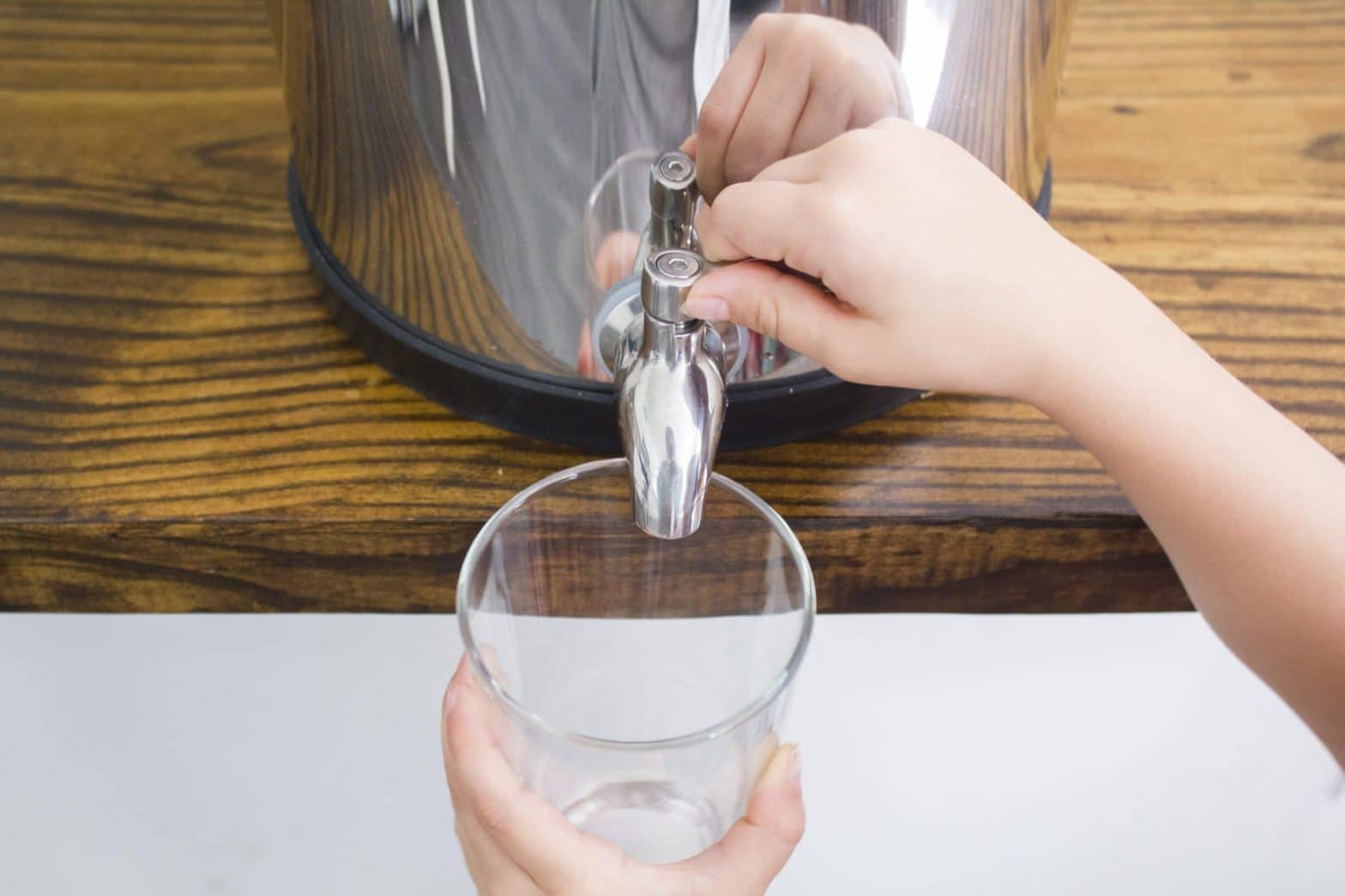
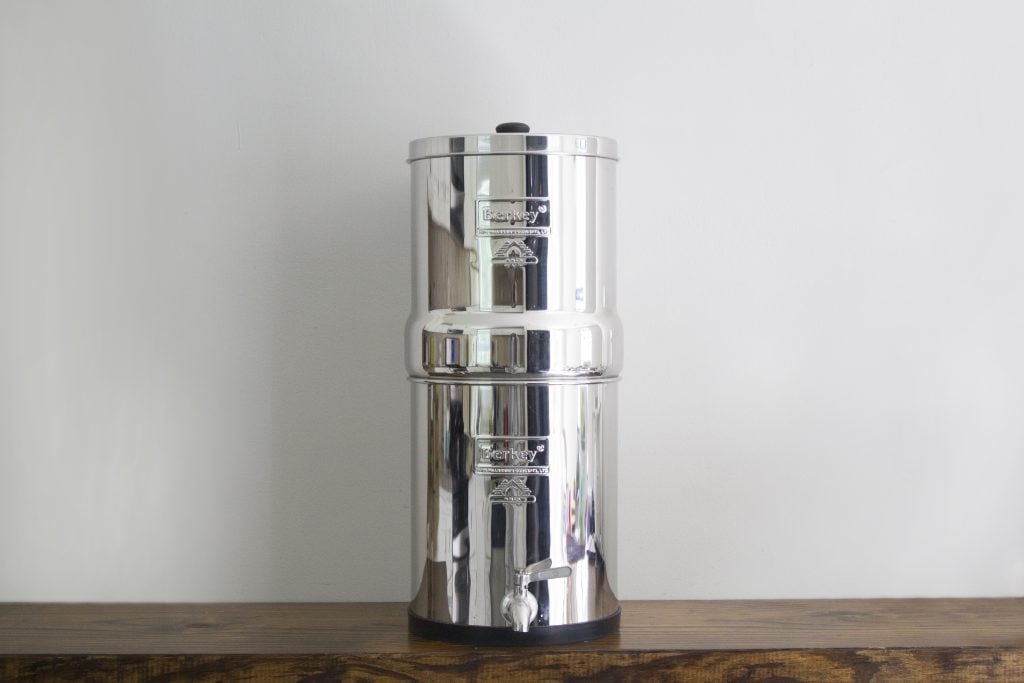
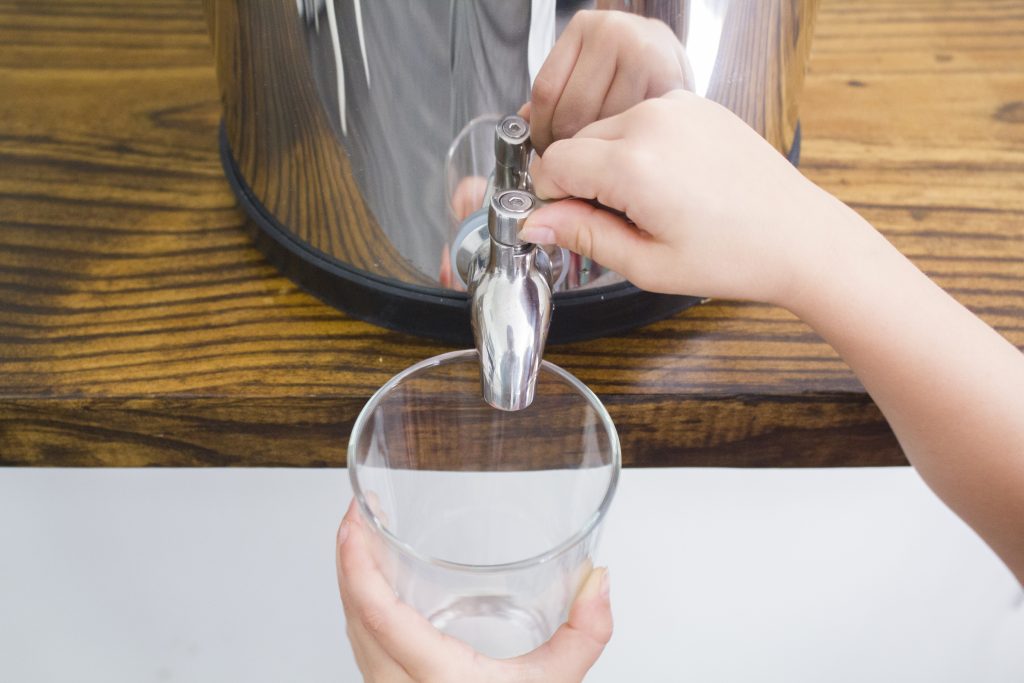

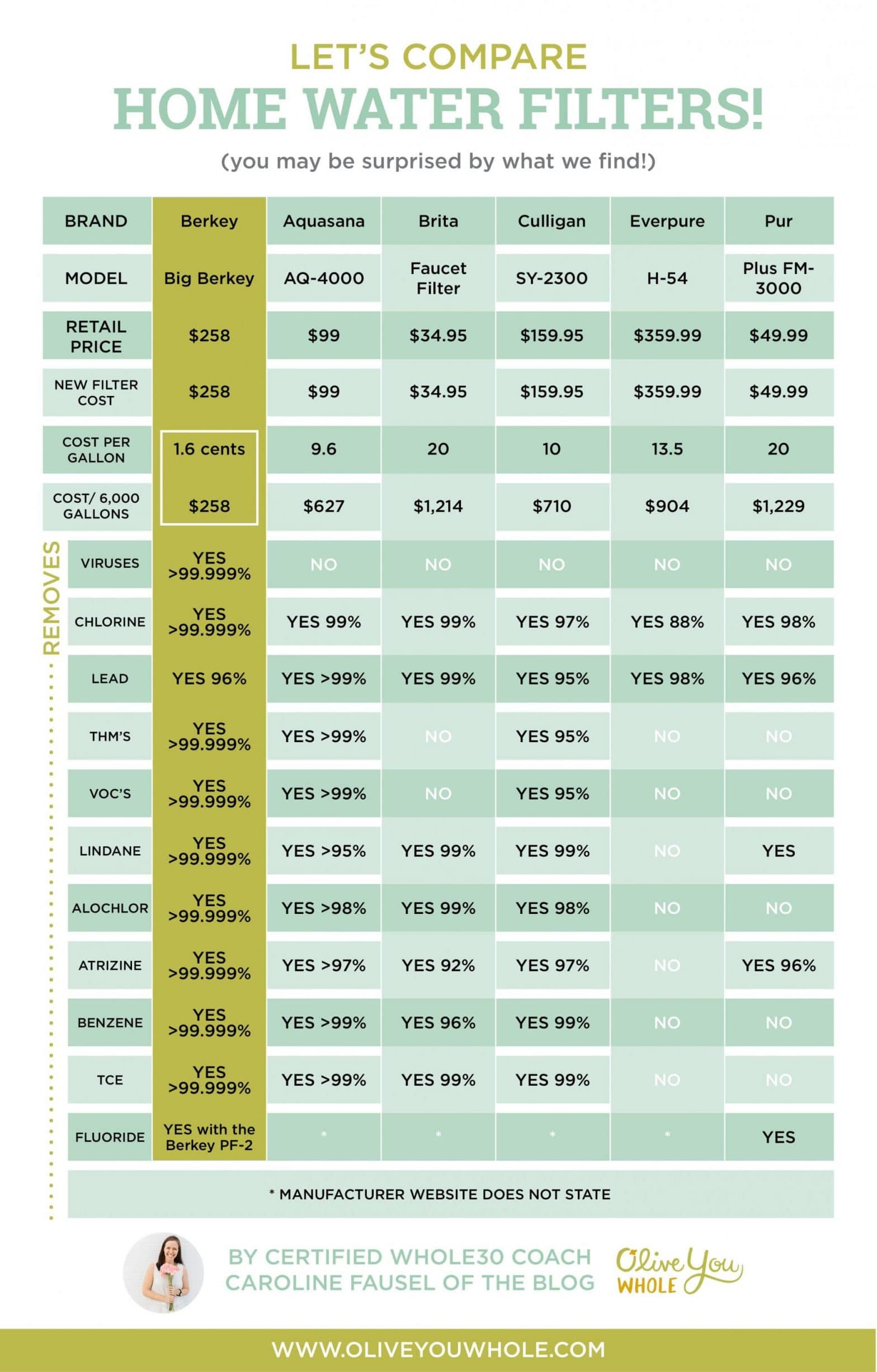
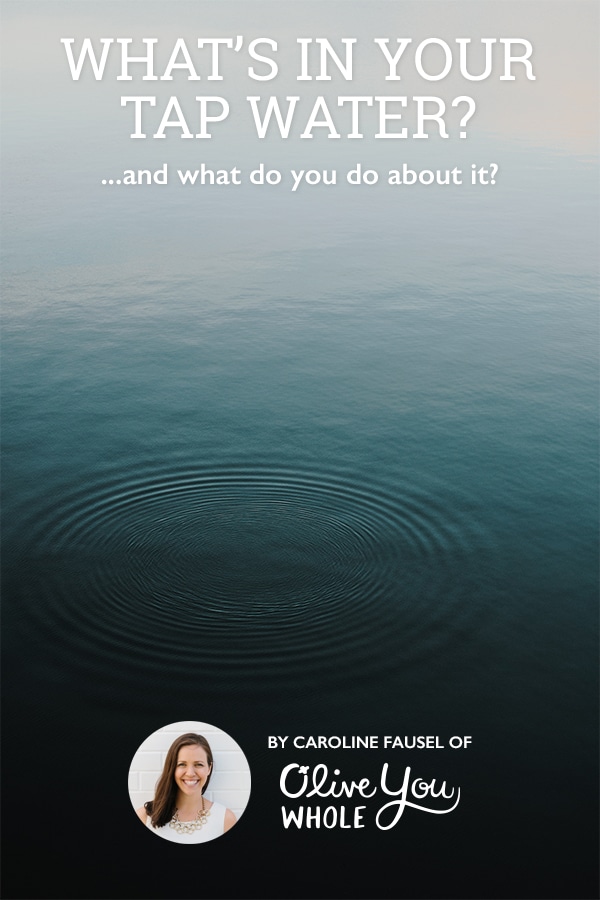

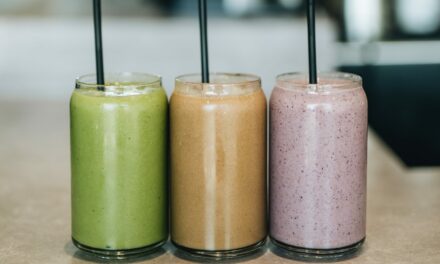



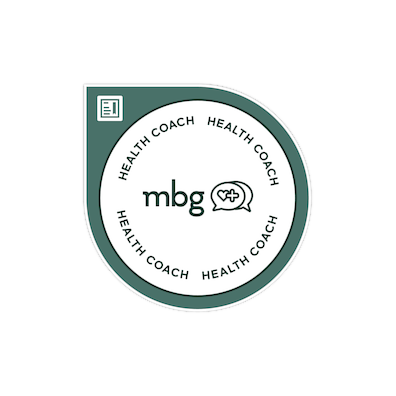

Hi! I love following you and really see you as a “go to” for all things health! Question about the Berkey…I have been reading Amazon reviews about the red dye test. Just curious to see if you tried it. I am looking for a good filtering system it’s just hard to know what to trust!
Hey Tina! I’m so thankful to hear that!! I haven’t tried it, but looks like Berkey suggests you try it, so I’m sure it works!
As far as the red dye test goes, that is the method for testing the black filters. You put red dye in the upper chamber and if the filters are working properly it will remove all the dye and the water will come out clear. Here is a link to the instructions for the red dye test. https://www.berkeyfilters.com/berkey-answers/how-to/black-berkey/test/ Let me know if there is anything else that I can help with!
If you decide to get a Berkey, this is the one we have and love! http://www.berkeyfilters.com/berkey-water-filters/systems/?a_aid=5afdc22c8cffb&a_bid=55078429
Thank you for the terrific article
This is actually useful, thanks.
I enjoy the article